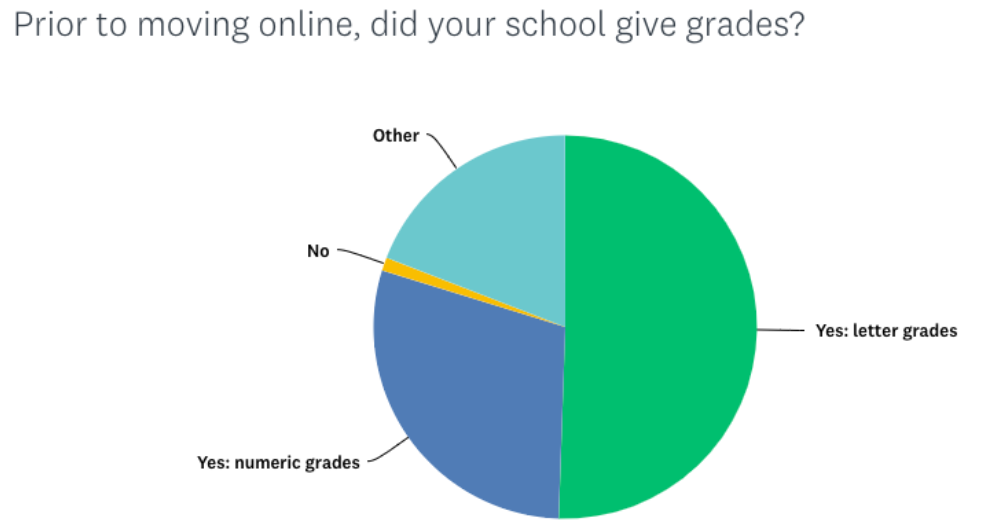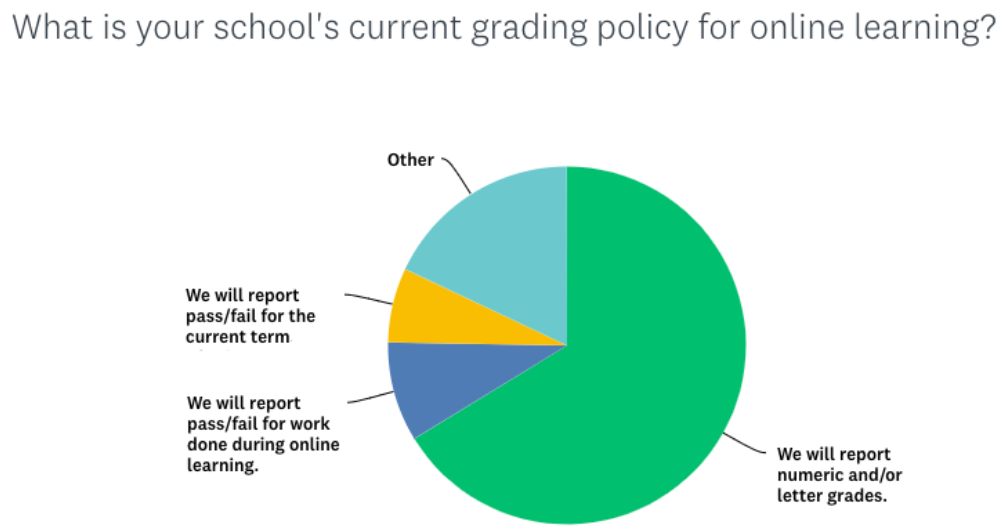Compassion, Equity, Rigor: GOA’s Review of Grading Policies for Learning Online
This is the second post of a two-part series on scheduling and grading during COVID-19. You can read part one, on schedules, here. Visit GOA’s COVID-19 landing page for our latest resources, offerings, and events.
How should we think about grading during COVID-19?
In early April 2020, GOA conducted a survey of independent and international schools, seeking to gather data about how they were approaching schedule and grading policy while learning online during the COVID-19 crisis. As with their schedules, schools are taking a variety of approaches to grading, with the many schools not fully committed to a certain policy and open to making adjustments the more time they spend learning online.
The Survey by the Numbers
GOA analyzed the responses of 89 independent and international schools, 34 of which are members of our consortium. Of the 89 respondents, 63 are based in the United States. Sixty-three schools have an elementary school division, 73 have a middle school, and 77 have a high school. Twelve of the respondents serve only elementary and/or middle school students. (List of respondents). Dates of an official move online ranged from January 27 to April 6, 2020, with the majority of respondents moving online sometime in March.
The survey asked a series of questions about how schools designed schedules and grading policies for a move online. The survey included a request for samples of and rationales for schedules and grading policies. This post focuses on grading policy.
What the Data Showed


All data is a snapshot in time, but that is especially important to keep in mind for this set of data, when most respondents said their policies are in flux. Compared to their online schedules, schools had fewer documents and samples of grading policies to share, in many cases because those policies have not yet been written.
Prior to moving online, 80% of respondents reported letter or numeric grades,. A number of schools cited other modes of grading and assessment (International Baccalaureate’s 1-7 scale, standards-based grading, etc.). Only one school reported not giving grades before moving online.
Of the 89 respondents, 14 (16%) reported a definitive adoption of a Pass/Fail, Pass/No Pass, or Pass/Incomplete system once they moved online. Twelve of those schools are high schools or have high school divisions. Eight of those schools said they would use the policy for the time the school is learning online, while six said it would be their policy for the entire term, whether or not the entire term is spent online.
While most schools (66%) said their current plans involve reporting grades of some kind, a significant subset of those schools said they 1) had made adjustments to normal grading policies given the sudden move online and 2) were open to changing their grading policies as they spend more time learning remotely. Three of these schools said that they were waiting for more guidance from scholarship providers and college admissions offices before finalizing their policies.
Key Trends
When asked for the rationale for their grading policies, schools shared responses that fell into three main categories.
Compassion
Among schools who plan to report letter or numeric grades, many are adjusting internal practices to what one respondent called “compassionate grading.” Six schools said they have adopted or are considering adopting a “do no harm” grading policy where students’ final grades from the previous term are set as a floor, and students can only raise those averages through work done while learning online, not lower them. For one example of what this policy might look like, see Lakeside School’s March 26, 2020, letter to Upper School students. The Lovett School is taking a different approach: offering the option to move from numeric to letter grades.
For schools who have not officially changed how they are reporting or calculating grades, there is still an overall effort to lower the stakes with assessments. Three schools said they have canceled or are considering canceling final exams. Others have made the general request to teachers that they be flexible with assignment deadlines. Other schools have adopted language similar to St. Christopher’s School’s directive to prioritize formative assessment.
Equity
Schools that have made the shift from numeric/letter grades to a Pass/Fail or similar format cited equity as a concern.
“We did not wish to hold students accountable in a high stakes way when even our most experienced faculty are, with respect to distance learning tools, novice teachers and designers. Also: we are working hard to provide every student with what they need to learn but cannot guarantee equity in resources and access. Finally, we expect high levels of stress all around as families are packed in small spaces, face economic insecurity, and deal with illness directly or through loved ones. No students or faculty need more stress than that!” said Dana Kooistra, Director of Teaching, Learning, and External Partnerships at The Lawrenceville School.
Citing similar concerns about the “newness” of the format and circumstances, Oregon Episcopal School sent this letter to students and families about its pass/fail policy.
Justin Cerenzia, Dean of Teaching & Learning and Director of the Merck Center for Teaching at St. George’s School, focused more specifically on the relationship between assessment and grading: “If we grade students now, we’re not measuring learning. We’re measuring their home environment—and that’s inherently inequitable. And, we’ve worked hard to limit those barriers (sending hot spots to families in need, etc.) but we have international students in quarantine at home with no access and firewall issues. It would be ridiculous to suggest grades reflect learning at this point.”
Rigor
Rigor and motivation came up in rationales for keeping a letter or numeric grading system while learning online.
Jen Sciortino, Director of Academic Excellence at Metairie Park Country Day School, said the school was reporting grades “to keep with a routine and to keep our students motivated... however, we are granting leniency with due dates and expectations because we recognize this is not an equitable learning situation for all.”
“We want to preserve both the rigor of our program and motivation for students to work hard even though it feels like they are ‘not at school’ anymore,” said Gregory Cooper, Upper School Dean of Studies at Ransom Everglades School. “Our teachers are largely working to replicate our in-school curriculum as much as possible, and although some of our assessment approaches might differ slightly, we did not see a need to alter our approach to grading.”
Dean Van Doleweerd, Assistant Head—Academics at Lakefield College School, said his school’s decision to keep reporting grades but with more flexibility and forgiveness achieved six goals: “1. Maintain community as the central element of the school experience. 2. Minimize change for students, parents, and teachers. 3. Maintain high expectations 4. Recognize that valuable and excellent work will still be completed at this time, while also recognizing that individual circumstances will make this more and less possible (for everyone in our community). 5. Create a sense of opportunity about the weeks ahead. 6. Remove as much threat from the process as possible."
What’s Next: A New Normal?
Reviewing the schedules and grading policies of 89 schools didn’t offer a clear, singular approach to remote/online/distance learning, nor should it have. These schools are based around the world, serve a variety of students and families, and are facing an unprecedented global health crisis. Improvisation, responsiveness, and customization are to be expected.
It’s impossible, however, not to notice that many of the design elements schools are adopting right now align with pre-COVID conversations about learner-centered shifts in education: creativity about use of time and space, expanded notions of what and how to assess, leveraging online spaces for personalized and student-led learning, and institutional decisions driven by flexibility, wellness, sustainability, compassion, equity, and rigor. Whereas before COVID-19 these were changes we hoped for or were experimenting with, they are now actions many schools believe they must take, can take, and are taking.
Recommended Resources
- Assessments and Grading in the Midst of a Pandemic (Thomas Guskey, author of On Your Mark)
- Comprehensive (and Growing) List of Grading Policies at Colleges and Universities (Laura Gibbs, University of Oklahoma)
- COVID-19 QuickPoll: Grading and Proctoring at Colleges and Universities (Educause)
- Recommendations for Grading During COVID-19 (Joe Feldman, author of Grading for Equity)
- Statement on Grading/Crediting During COVID-19 from the Mastery Transcript Consortium and Challenge Success
This is the second post of a two-part series on scheduling and grading during COVID-19. You can read Part One, on schedules, here. Visit GOA’s COVID-19 landing page for our latest resources, offerings, and events. To learn more about our approach to online learning, explore our Student Program and Professional Learning offerings.
